Rui Min
Evaluating Large Language Model with Knowledge Oriented Language Specific Simple Question Answering
May 22, 2025Abstract:We introduce KoLasSimpleQA, the first benchmark evaluating the multilingual factual ability of Large Language Models (LLMs). Inspired by existing research, we created the question set with features such as single knowledge point coverage, absolute objectivity, unique answers, and temporal stability. These questions enable efficient evaluation using the LLM-as-judge paradigm, testing both the LLMs' factual memory and self-awareness ("know what they don't know"). KoLasSimpleQA expands existing research in two key dimensions: (1) Breadth (Multilingual Coverage): It includes 9 languages, supporting global applicability evaluation. (2) Depth (Dual Domain Design): It covers both the general domain (global facts) and the language-specific domain (such as history, culture, and regional traditions) for a comprehensive assessment of multilingual capabilities. We evaluated mainstream LLMs, including traditional LLM and emerging Large Reasoning Models. Results show significant performance differences between the two domains, particularly in performance metrics, ranking, calibration, and robustness. This highlights the need for targeted evaluation and optimization in multilingual contexts. We hope KoLasSimpleQA will help the research community better identify LLM capability boundaries in multilingual contexts and provide guidance for model optimization. We will release KoLasSimpleQA at https://github.com/opendatalab/KoLasSimpleQA .
Improving Your Model Ranking on Chatbot Arena by Vote Rigging
Jan 29, 2025Abstract:Chatbot Arena is a popular platform for evaluating LLMs by pairwise battles, where users vote for their preferred response from two randomly sampled anonymous models. While Chatbot Arena is widely regarded as a reliable LLM ranking leaderboard, we show that crowdsourced voting can be rigged to improve (or decrease) the ranking of a target model $m_{t}$. We first introduce a straightforward target-only rigging strategy that focuses on new battles involving $m_{t}$, identifying it via watermarking or a binary classifier, and exclusively voting for $m_{t}$ wins. However, this strategy is practically inefficient because there are over $190$ models on Chatbot Arena and on average only about $1\%$ of new battles will involve $m_{t}$. To overcome this, we propose omnipresent rigging strategies, exploiting the Elo rating mechanism of Chatbot Arena that any new vote on a battle can influence the ranking of the target model $m_{t}$, even if $m_{t}$ is not directly involved in the battle. We conduct experiments on around $1.7$ million historical votes from the Chatbot Arena Notebook, showing that omnipresent rigging strategies can improve model rankings by rigging only hundreds of new votes. While we have evaluated several defense mechanisms, our findings highlight the importance of continued efforts to prevent vote rigging. Our code is available at https://github.com/sail-sg/Rigging-ChatbotArena.
WanJuanSiLu: A High-Quality Open-Source Webtext Dataset for Low-Resource Languages
Jan 24, 2025



Abstract:This paper introduces the open-source dataset WanJuanSiLu, designed to provide high-quality training corpora for low-resource languages, thereby advancing the research and development of multilingual models. To achieve this, we have developed a systematic data processing framework tailored for low-resource languages. This framework encompasses key stages such as data extraction, corpus cleaning, content deduplication, security filtering, quality evaluation, and theme classification. Through the implementation of this framework, we have significantly improved both the quality and security of the dataset, while maintaining its linguistic diversity. As of now, data for all five languages have been fully open-sourced. The dataset can be accessed at https://opendatalab.com/applyMultilingualCorpus, and GitHub repository is available at https://github.com/opendatalab/WanJuan3.0
RM-Bench: Benchmarking Reward Models of Language Models with Subtlety and Style
Oct 21, 2024



Abstract:Reward models are critical in techniques like Reinforcement Learning from Human Feedback (RLHF) and Inference Scaling Laws, where they guide language model alignment and select optimal responses. Despite their importance, existing reward model benchmarks often evaluate models by asking them to distinguish between responses generated by models of varying power. However, this approach fails to assess reward models on subtle but critical content changes and variations in style, resulting in a low correlation with policy model performance. To this end, we introduce RM-Bench, a novel benchmark designed to evaluate reward models based on their sensitivity to subtle content differences and resistance to style biases. Extensive experiments demonstrate that RM-Bench strongly correlates with policy model performance, making it a reliable reference for selecting reward models to align language models effectively. We evaluate nearly 40 reward models on RM-Bench. Our results reveal that even state-of-the-art models achieve an average performance of only 46.6%, which falls short of random-level accuracy (50%) when faced with style bias interference. These findings highlight the significant room for improvement in current reward models. Related code and data are available at https://github.com/THU-KEG/RM-Bench.
Uncovering, Explaining, and Mitigating the Superficial Safety of Backdoor Defense
Oct 13, 2024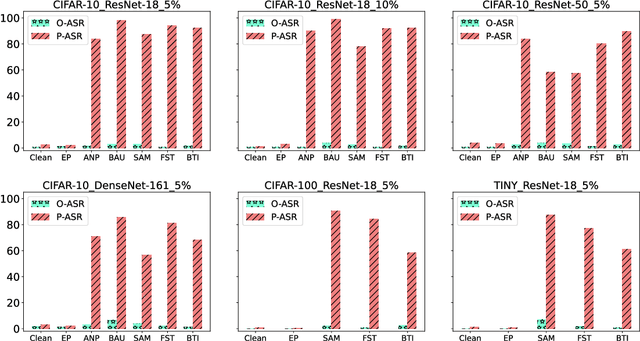
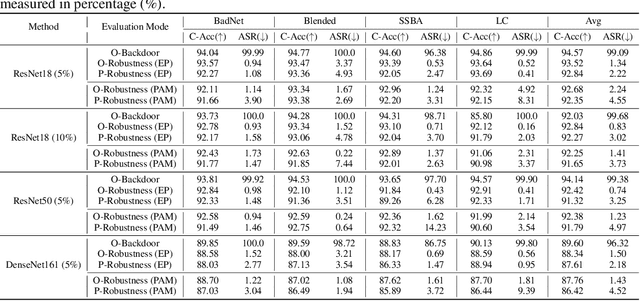


Abstract:Backdoor attacks pose a significant threat to Deep Neural Networks (DNNs) as they allow attackers to manipulate model predictions with backdoor triggers. To address these security vulnerabilities, various backdoor purification methods have been proposed to purify compromised models. Typically, these purified models exhibit low Attack Success Rates (ASR), rendering them resistant to backdoored inputs. However, Does achieving a low ASR through current safety purification methods truly eliminate learned backdoor features from the pretraining phase? In this paper, we provide an affirmative answer to this question by thoroughly investigating the Post-Purification Robustness of current backdoor purification methods. We find that current safety purification methods are vulnerable to the rapid re-learning of backdoor behavior, even when further fine-tuning of purified models is performed using a very small number of poisoned samples. Based on this, we further propose the practical Query-based Reactivation Attack (QRA) which could effectively reactivate the backdoor by merely querying purified models. We find the failure to achieve satisfactory post-tuning robustness stems from the insufficient deviation of purified models from the backdoored model along the backdoor-connected path. To improve the post-purification robustness, we propose a straightforward tuning defense, Path-Aware Minimization (PAM), which promotes deviation along backdoor-connected paths with extra model updates. Extensive experiments demonstrate that PAM significantly improves post-purification robustness while maintaining a good clean accuracy and low ASR. Our work provides a new perspective on understanding the effectiveness of backdoor safety tuning and highlights the importance of faithfully assessing the model's safety.
Hardware Acceleration for Knowledge Graph Processing: Challenges & Recent Developments
Aug 22, 2024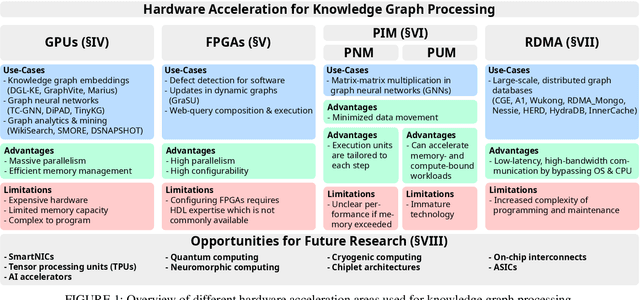
Abstract:Knowledge graphs (KGs) have achieved significant attention in recent years, particularly in the area of the Semantic Web as well as gaining popularity in other application domains such as data mining and search engines. Simultaneously, there has been enormous progress in the development of different types of heterogeneous hardware, impacting the way KGs are processed. The aim of this paper is to provide a systematic literature review of knowledge graph hardware acceleration. For this, we present a classification of the primary areas in knowledge graph technology that harnesses different hardware units for accelerating certain knowledge graph functionalities. We then extensively describe respective works, focusing on how KG related schemes harness modern hardware accelerators. Based on our review, we identify various research gaps and future exploratory directions that are anticipated to be of significant value both for academics and industry practitioners.
Towards Stable Backdoor Purification through Feature Shift Tuning
Oct 07, 2023



Abstract:It has been widely observed that deep neural networks (DNN) are vulnerable to backdoor attacks where attackers could manipulate the model behavior maliciously by tampering with a small set of training samples. Although a line of defense methods is proposed to mitigate this threat, they either require complicated modifications to the training process or heavily rely on the specific model architecture, which makes them hard to deploy into real-world applications. Therefore, in this paper, we instead start with fine-tuning, one of the most common and easy-to-deploy backdoor defenses, through comprehensive evaluations against diverse attack scenarios. Observations made through initial experiments show that in contrast to the promising defensive results on high poisoning rates, vanilla tuning methods completely fail at low poisoning rate scenarios. Our analysis shows that with the low poisoning rate, the entanglement between backdoor and clean features undermines the effect of tuning-based defenses. Therefore, it is necessary to disentangle the backdoor and clean features in order to improve backdoor purification. To address this, we introduce Feature Shift Tuning (FST), a method for tuning-based backdoor purification. Specifically, FST encourages feature shifts by actively deviating the classifier weights from the originally compromised weights. Extensive experiments demonstrate that our FST provides consistently stable performance under different attack settings. Additionally, it is also convenient to deploy in real-world scenarios with significantly reduced computation costs. Our codes are available at https://github.com/AISafety-HKUST/stable_backdoor_purification.
Adaptive Perturbation Generation for Multiple Backdoors Detection
Sep 13, 2022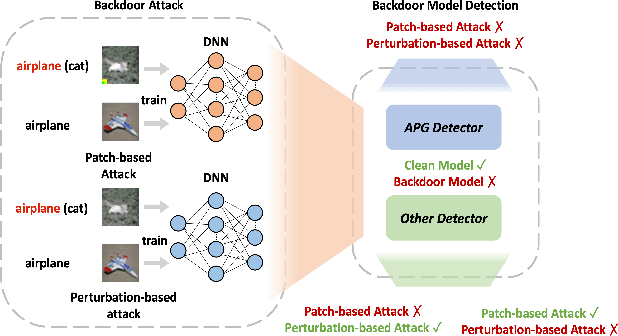
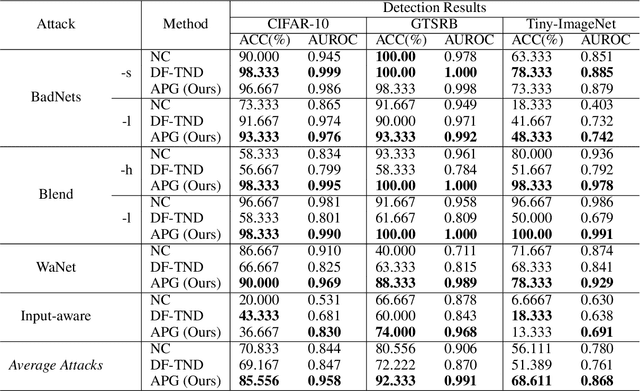
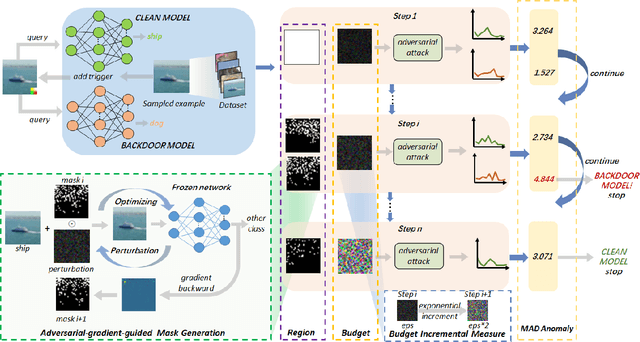

Abstract:Extensive evidence has demonstrated that deep neural networks (DNNs) are vulnerable to backdoor attacks, which motivates the development of backdoor detection methods. Existing backdoor detection methods are typically tailored for backdoor attacks with individual specific types (e.g., patch-based or perturbation-based). However, adversaries are likely to generate multiple types of backdoor attacks in practice, which challenges the current detection strategies. Based on the fact that adversarial perturbations are highly correlated with trigger patterns, this paper proposes the Adaptive Perturbation Generation (APG) framework to detect multiple types of backdoor attacks by adaptively injecting adversarial perturbations. Since different trigger patterns turn out to show highly diverse behaviors under the same adversarial perturbations, we first design the global-to-local strategy to fit the multiple types of backdoor triggers via adjusting the region and budget of attacks. To further increase the efficiency of perturbation injection, we introduce a gradient-guided mask generation strategy to search for the optimal regions for adversarial attacks. Extensive experiments conducted on multiple datasets (CIFAR-10, GTSRB, Tiny-ImageNet) demonstrate that our method outperforms state-of-the-art baselines by large margins(+12%).
State space partitioning based on constrained spectral clustering for block particle filtering
Mar 07, 2022
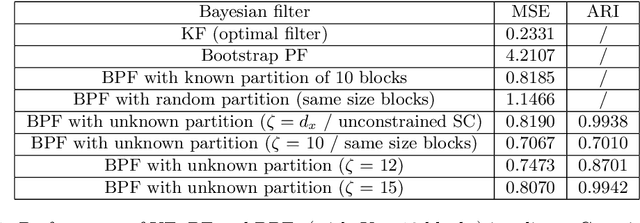
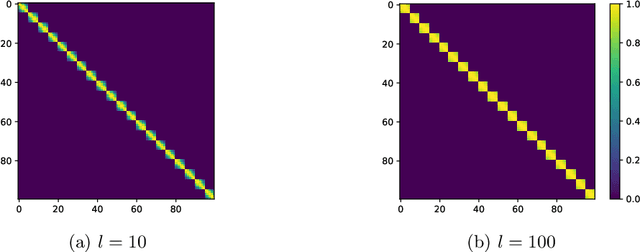
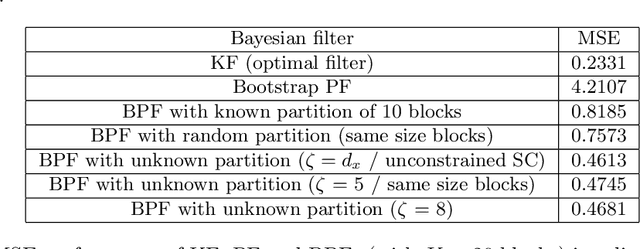
Abstract:The particle filter (PF) is a powerful inference tool widely used to estimate the filtering distribution in non-linear and/or non-Gaussian problems. To overcome the curse of dimensionality of PF, the block PF (BPF) inserts a blocking step to partition the state space into several subspaces or blocks of smaller dimension so that the correction and resampling steps can be performed independently on each subspace. Using blocks of small size reduces the variance of the filtering distribution estimate, but in turn the correlation between blocks is broken and a bias is introduced. When the dependence relationships between state variables are unknown, it is not obvious to decide how to split the state space into blocks and a significant error overhead may arise from a poor choice of partitioning. In this paper, we formulate the partitioning problem in the BPF as a clustering problem and we propose a state space partitioning method based on spectral clustering (SC). We design a generalized BPF algorithm that contains two new steps: (i) estimation of the state vector correlation matrix from predicted particles, (ii) SC using this estimate as the similarity matrix to determine an appropriate partition. In addition, a constraint is imposed on the maximal cluster size to prevent SC from providing too large blocks. We show that the proposed method can bring together in the same blocks the most correlated state variables while successfully escaping the curse of dimensionality.
 Add to Chrome
Add to Chrome Add to Firefox
Add to Firefox Add to Edge
Add to Edge